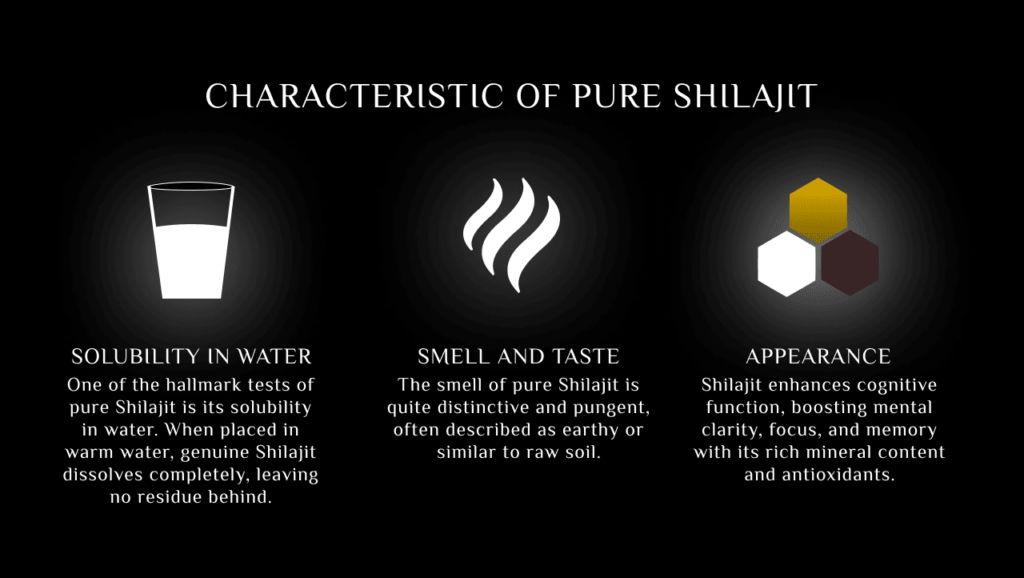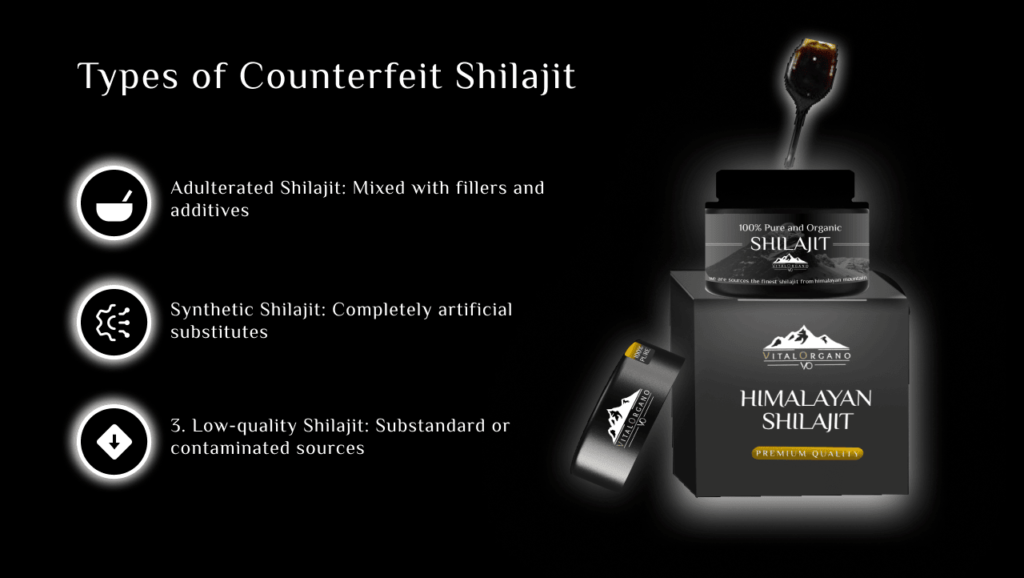Introduction
Shilajit, a renowned substance in traditional Ayurvedic medicine, has gained widespread popularity in recent years for its numerous health benefits.
Extracted from rocks in high mountain ranges, Shilajit is prized for its rejuvenating properties, which include enhancing energy levels, improving cognitive function, and supporting overall well-being.
However, with its rising demand, the market has unfortunately seen a surge in counterfeit and adulterated products, making it challenging for consumers to find genuine Shilajit.
Understanding how to identify pure Shilajit is crucial for anyone looking to harness its full potential while avoiding harmful impurities and ineffective substitutes.
The key to reaping the benefits of Shilajit lies in ensuring its purity. Pure Shilajit is characterized by its distinctive appearance, smell, taste, and solubility.
Genuine Shilajit typically has a dark, tar-like consistency, a slightly bitter taste, and a pungent smell. It dissolves completely in warm water, leaving no residue, which is a good initial test of its authenticity.
Conversely, counterfeit Shilajit may be mixed with fillers, synthetics, or other additives, compromising its efficacy and safety.
To navigate the complexities of the Shilajit market, it’s essential to be informed about the characteristics of pure Shilajit and the common types of counterfeits.
By sourcing Shilajit from reputable suppliers, verifying certifications, and conducting simple home tests, you can significantly reduce the risk of purchasing an inferior product.
This article, “How to Identify Pure Shilajit: Tips for Avoiding Counterfeit Products” provides comprehensive guidance to help you distinguish genuine Shilajit from fakes.
By following these tips, you can make informed decisions, ensuring that the Shilajit you use is both safe and effective, allowing you to fully enjoy its remarkable health benefits.
1. Characteristics of Pure Shilajit:

· Appearance: Color, Texture, and Consistency
Pure Shilajit is typically dark brown or blackish in color. It has a shiny, tar-like appearance with a sticky, resinous texture. The consistency is thick and gooey at room temperature but becomes more pliable and softer when warmed slightly.
Unlike many counterfeit products that may appear grainy or lack luster, genuine Shilajit has a smooth, homogeneous texture without any visible impurities or additives.
· Smell and Taste: Distinctive Characteristics of Genuine Shilajit
The smell of pure Shilajit is quite distinctive and pungent, often described as earthy or similar to raw soil. This unique aroma can be off-putting to some but is a key indicator of its authenticity.
In terms of taste, genuine Shilajit is bitter and slightly acrid. The taste is strong and pronounced, lingering on the palate, which sets it apart from diluted or fake versions that may lack this intensity
· Solubility: How Pure Shilajit Dissolves in Water
One of the hallmark tests of pure Shilajit is its solubility in water. When placed in warm water, genuine Shilajit dissolves completely, leaving no residue behind. The solution should become a uniform dark brown or blackish color.
This solubility is an important indicator, as counterfeit products often do not dissolve fully, leaving behind sediment or particulate matter.
The complete dissolution in water confirms the purity and quality of Shilajit, ensuring it is free from fillers and contaminants.
2. Common Types of Counterfeit Shilajit

· Adulterated Shilajit: Mixed with fillers and additives
One prevalent form of counterfeit Shilajit is adulterated Shilajit, which is mixed with various fillers and additives to increase volume and reduce costs. These fillers can include soil, plant matter, or other substances that dilute the potency of the Shilajit, rendering it less effective.
Adulterated Shilajit often lacks the distinctive characteristics of pure Shilajit, such as its sticky texture and unique smell, making it easier to identify with careful inspection.
· Synthetic Shilajit: Completely artificial substitutes
Another common type of counterfeit Shilajit is synthetic Shilajit, which is entirely artificial and manufactured to mimic the appearance and properties of genuine Shilajit.
These substitutes are usually made from chemicals and synthetic compounds that do not offer the same health benefits as real Shilajit.
Synthetic Shilajit may look similar to pure Shilajit but often fails the solubility test, as it does not dissolve completely in water and leaves a residue. The taste and smell of synthetic Shilajit are often markedly different from that of authentic Shilajit.
· Low-quality Shilajit: Substandard or contaminated sources
Low-quality Shilajit comes from substandard or contaminated sources, which compromises its effectiveness and safety.
This type of Shilajit may be harvested from areas with high levels of pollution or processed without proper purification methods, leading to the presence of heavy metals and other toxins.
Low-quality Shilajit can pose significant health risks due to these contaminants. It may also have a dull appearance, inconsistent texture, and an unpleasant taste, all of which indicate its inferior quality.
3. Tips for Identifying Pure Shilajit
· Source Verification: Checking the origin and harvesting location
One of the first steps in identifying pure Shilajit is verifying its source. Authentic Shilajit is typically harvested from high mountain ranges, particularly the Himalayas.
Checking the origin and ensuring that the Shilajit is sourced from a reputable region known for its quality can provide assurance of its authenticity.
Reliable suppliers should be transparent about where their Shilajit comes from and how it is harvested.
Another crucial tip is to look for Shilajit that has been certified and lab-tested by third-party organizations.
Certificates of analysis (COAs) from independent labs can confirm the purity and quality of the product, indicating that it is free from harmful contaminants such as heavy metals and pesticides. These tests also verify that the Shilajit contains the expected levels of beneficial compounds, ensuring its efficacy.
· Brand Reputation: Researching reputable brands and suppliers
Choosing Shilajit from reputable brands and suppliers is key to avoiding counterfeit products. Researching the brand’s history, reading customer reviews, and checking for endorsements from trusted sources can help determine the reliability of a supplier.
Established brands with a strong reputation are more likely to offer genuine, high-quality Shilajit.
· Price Consideration: Understanding the cost of pure Shilajit versus counterfeit products
Price can also be an indicator of quality when it comes to Shilajit. Genuine, pure Shilajit is often more expensive due to the complex and labor-intensive harvesting and purification processes.
If a product is significantly cheaper than the average market price, it may be a red flag indicating adulteration or counterfeit. While cost alone is not a definitive measure of quality, extremely low prices should prompt further scrutiny of the product’s authenticity.
4. Home Tests for Verifying Shilajit
· Water Solubility Test: Observing how Shilajit dissolves in water
One of the simplest and most effective home tests to verify Shilajit’s purity is the water solubility test. To perform this test, take a small amount of Shilajit and place it in a glass of warm water.
Pure Shilajit should dissolve completely, resulting in a homogeneous dark brown or blackish solution with no residue or sediment left at the bottom.
If the Shilajit does not dissolve fully or leaves behind particles, it may be adulterated or of low quality.
· Pliability Test: Checking the texture and consistency at different temperatures
Another useful test is the pliability test, which involves examining the texture and consistency of Shilajit at various temperatures.
Pure Shilajit is known for its unique ability to change consistency with temperature. At room temperature, it should be thick, sticky, and tar-like.
When slightly warmed, it becomes softer and more pliable, whereas cooling it should make it firmer. If the Shilajit remains hard and brittle or does not change consistency with temperature variations, it could be synthetic or impure.
· Flame Test: Assessing the reaction of Shilajit to heat
The flame test is another straightforward method to check for Shilajit’s authenticity. Take a small piece of Shilajit and expose it to a flame, such as from a lighter or candle.
Pure Shilajit should melt and bubble but not burn with a flame or produce significant smoke. If the substance catches fire, produces a lot of smoke, or leaves an ash residue, it is likely to be adulterated or synthetic.
This test helps in identifying additives or impurities that are not present in pure Shilajit.
By conducting these home tests, the water solubility test, the pliability test, and the flame test, you can assess the purity and authenticity of your Shilajit. These simple yet effective methods provide valuable insights into the quality of the product, helping you avoid counterfeit or low quality Shilajit and ensuring you reap the full benefits of this powerful natural supplement.
Conclusion
Identifying pure Shilajit is crucial for ensuring you receive its full health benefits while avoiding potential risks from counterfeit products.
By understanding and examining its key characteristics appearance, smell, taste, and solubility you can distinguish genuine Shilajit from fake or adulterated versions. Be vigilant about the source, looking for certifications and lab tests to confirm its purity.
Researching reputable brands and being mindful of price discrepancies can further guide you in making an informed purchase.
Additionally, simple home tests like the water solubility test, pliability test, and flame test offer practical ways to verify the authenticity of Shilajit.
With the knowledge gained from this article, “How to Identify Pure Shilajit: Tips for Avoiding Counterfeit Products,” you are better equipped to navigate the market confidently.
Ensuring you have pure, high-quality Shilajit means you can safely enjoy its rejuvenating properties and enhance your overall well-being. Stay informed, be cautious, and make decisions that prioritize your health and safety.




